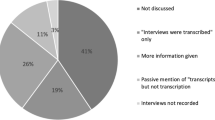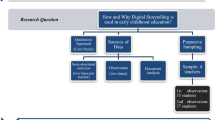Abstract
“Public sociology” has flourished as an idea with limited success in practice. We argue that movement towards the consensual goal of public engagement is more likely using audiovisual than text-based communication. We briefly review the history of the idea with a focus on the post-Burawoy era and its central debates. We argue that such disputes over politics, activism, disciplinary identity, and theoretical coherence are diversionary, with little hope of resolution and even less of providing the engagement sought by public sociology. Sadly and wrongly, they assume that only educated and literate audiences possess interest or capacity to engage scholarly knowledge of the social world. Advances in audiovisual technologies, familiarization, and routinization during the past decade suggest a solution that does not involve significant structural or cultural changes to the discipline. In this essay we offer two illustrations of audiovisual practices in sociology and provide an overview of video ethnography as an option in graduate methods training. This proposed course is a reasonable, low cost, and implementable solution to the problem of public sociology.
Similar content being viewed by others
Notes
Also referred to as “digital video,” “ethnographic film,” “audiovisual ethnography,” “visual ethnography,” and “auto-ethnography” (the process by which non-ethnographers become filmmakers to communicate their research).
We note that the terms “video,” “film,” and “movies” do not appear in any of Burawoy’s seven main publications on public sociology.
These discussions featured in major journals, including The American Sociologist, American Sociological Review, British Journal of Sociology, Social Problems, Social Forces, Critical Sociology, Sociology, and Current Sociology. Books and collected essays began to appear including case studies of public sociology (Blau and Smith 2006; Agger 2007; Clawson et al. 2007; Nichols 2011; Barlow 2007; Jacobsen 2008; Haney 2008).
In one of the most incisive critiques of public sociology, Boyns and Fletcher examine the contradiction between Burawoy’s vision of sociology as many tributaries flowing into a common stream and his description of internal divisions, power struggles, and the dominance of a professional society (2005).
We prefer the term “auto-ethnography” to describe the process by which a quantitative or non-ethnographic sociologist makes movies.
Clearly, Marx and Engels did not think so.
It is trivial to argue that less educated social actors may not understand the vocabulary or discursive patterns of more educated actors (this is also true in reverse), or that subtitled films cannot be understood by those who cannot read (they may be dubbed). The example of Brother Time (Kenya 2012) in the next section illustrates a related point. This film about ethnic violence following the 2007 Presidential election had to be subtitled in English even though all of the Kenyans in the movie speak English. The language proved to be difficult for all but native Kenyans to understand.
The full movie may be viewed at http://brothertime.org.
Dr. Ellis Njoka, then Professor of Agronomy at Egerton.
“B-roll” is supplementary footage that is used to illustrate and diversify, and deepen the audio experience of audio in a documentary. It is placed “over” (above) the main video and audio tracks in an editing timeline.
The process of completion involved several trips to Kenya to work with Dr. Mbatia after the initial 2008 filming. During the next visit, one year later, we discovered that Wainaina and his neighbor Thomas Mutai, were again fast friends, treating the “clashes” as yet another instance of politicians exploiting he populace for personal gain. Since the reunion itself had already taken place, a representative scene, involving the fathers and young sons, was filmed for the ending of the movie. One may argue over its legitimacy as scholarship, but in the context of the next election, with its potential for violence, the message of peace was paramount for the future.
Examples of this are extremely common but there are generational patterns. Younger informants are more alert to opportunities and constraints of filming—but we have not found them to be less self-conscious about the presence of recording devices.
Except in rare cases, omnidirectional microphones are not recommended for audiovisual recording.
Our policy is to provide our footage to the subjects whenever they wish, such that they may themselves publish what we have filmed.
The inclination to wish “the camera was still rolling” during the deflection should be avoided.
Louisiana State University has instituted an optional graduate methods seminar for Video Ethnography every other year. The seminar does not replace the traditional seminar on ethnographic methods.
The new Journal of Video Ethnography, edited by Greg Scott at DePaul University, requires submitters to provide a “statement concerning the theoretical, conceptual framework/perspective that influenced your making of this film” and a “short list of key scholarly references (e.g., peer-reviewed articles, books, films) that situate/contextualize your film in a body of empirical research literature.”
After some experience with attached microphones, wireless microphones are soon preferable.
According to a 2009 study (Rideout et al. 2010), children between the ages of 8–18 spent 7.5 h a day engaged with some type of electronic media.
Five years ago the first author was asked by a professional filmmaker, who typically used feature film equipment in the hundreds of thousands of dollars, what it cost to “get in the game” at an amateur level. At that time the answer was “about $5,000.” Now the answer is closer to $2,000 for a complete system to make a film of reasonable quality, from beginning to distribution.
Our position is that peer-reviewed movies are crucial to the development of video in the academic career, but is not relevant to public engagement.
References
Agger, B. (2007). Public sociology: From social facts to literary acts. Lanham: Rowman & Littlefield.
Barlow, A. (Ed.). (2007). Collaborations for social justice. Lanham: Rowman & Littlefield.
Blau, J. R., & Smith, K. E. I. (2006). Public sociologies reader. Lanham: Rowman & Littlefield.
Boyns, D., & Jesse Fletcher, M. A. (2005). Reflections on public sociology: public relations, disciplinary identity, and the strong program in professional sociology. The American Sociologist, 36(3–4), 5–26.
Brady, D. (2004). Why public sociology may fail. Social Forces, 82(4), 1629–1638.
Breiger, R. (1974). The duality of persons and groups. Social Forces, 53(2), 181–190.
Burawoy, M. (2005). For public sociology. American Sociological Review, 70(1), 4–28.
Burawoy, M. (2009). The public sociology wars. In V. Jeffries (Ed.), Handbook of public sociology. Lanham: Rowman and Littlefield.
Burawoy, M., et al. (2004). Public sociologies: a symposium from Boston College. Social Problems, 51(1), 103–130.
Clawson, D., Zussman, R., Misra, J., Gerstel, N., & Stokes, R. (Eds.) (2007). Public sociology: Fifteen eminent sociologists debate politics and the profession in the twenty-first century. University of California Press.
Council, A. S. A. (2005). Public sociology and the roots of American sociology: Re-establishing our connections to the public. Washington, D.C.: American Sociological Association.
Frickel, S., & Gross, N. (2005). A general theory of scientific/intellectual movements. American Sociological Review, 70(2), 204–232.
Fuchs, S. (1992). The professional quest for truth: A social theory of science and knowledge. Albany: State University of New York Press.
Gans, H. J. (1989). Sociology in America: the discipline and the public American Sociological Association, 1988 presidential address. American Sociological Review, 54(1), 1–16.
Gans, H. (1998). Best sellers by sociologists. In D. Clawson (Ed.), Required reading (pp. 19–27). Amherst: University of Massachusetts Press.
Gans, H. (2009). A sociology for public sociology: Some needed disciplinary changes for creating public sociology. In V. Jeffries (Ed.), Handbook of public sociology (pp. 123–134). Lanham: Rowman and Littlefield.
Gans, H. J. (2010). Public ethnography: ethnography as public sociology. Qualitative Sociology, 33(1), 97–104.
Garrett, B. L. (2011). Videographic geographies: using digital video for geographic research. Progress in Human Geography, 35(4), 521–541.
Haney, D. (2008). The Americanization of social science: Intellectuals and public responsibility in the postwar United States. Philadelphia: Temple University Press.
Harper, D. (2012). Visual sociology. New York: Routledge.
Jacobsen, M. H. (Ed.). (2008). Public sociology. Aalborg: Aalborg University Press.
Jacoby, R. (1987). The last intellectuals: American culture in the age of academe. New York: Basic.
Jeffries, V. (Ed.). (2009). Handbook of public sociology. Lanham: Rowman & Littlefield.
Kalekin-Fishman, D., & Denis, A. (Eds.). (2012). The shape of sociology for the 21st century: Tradition and renewal. Thousand Oaks: Sage.
Keith, M. (2008). Public sociology? Between heroic immersion and critical distance: Personal reflections on academic engagement with political life. Critical Social Policy, 28(3), 320–334.
Knoblauch, H., & Schnettler, B. (2012). Videography: analysing video data as a ‘focused’ ethnographic and hermeneutical exercise. Qualitative Research, 12(3), 334–356.
Morton, M., Dolgon, C., Maher, T., & Pennell, J. (2012). Civic engagement and public sociology two movements in search of a mission. Journal of Applied Social Science, 6(1), 5–30.
Mullins, N. (1973). Theories and theory groups in contemporary American sociology. New York: Harper and Row.
Nichols, L. T. (Ed.). (2011). Public sociology: The contemporary debate. Transaction Books.
Nielsen, F. (2004). The vacant “we”: remarks on public sociology. Social Forces, 82(4), 1619–1627.
Pink, S. (2007). Doing visual ethnography: Images, media and representation in research (2nd ed.). London: Sage.
Powell, C. (2012). How epistemology matters: five reflexive critiques of public sociology. Critical Sociology, 39(1), 87–104.
Revers, M. (2009). Sociologists in the press. The American Sociologist, 40(4), 272–288.
Rideout, V., Foehr, U. G., & Roberts, D. F. (2010). Generation M2: Media in the Lives of 8-to18-Year-Olds. Kaiser Family Foundation, January 2010. http://www.kff.org. Accessed June 2013.
Rona-Tas, A., & Gabay, N. (2007). The invisible science of the invisible hand–the public presence of economic sociology in the USA. Socio-Economic Review, 5(2), 319–367.
Shrum, W., Duque, R., & Brown, T. (2005). Digital video as research practice: methodology for the millennium. Journal of Research Practice, 1(1), Article-M4.
Shrum, W., Duque, R., & Ynalvez, M. (2007). Lessons of the lower ninth: the methodology and epistemology of video ethnography. Technology in Society, 29(2), 215–225.
Siebel, C., & Smith, K. (2009). How public are we? Coverage of sociology by the associated press. The American Sociologist, 40(4), 289–308.
Swedberg, R. (2007). Economic sociology as public sociology. Socio-Economic Review, 5, 319–367.
Tedlock, B. (2005). The observation and participation of and the emergence of public ethnography. In N. Denzin & Y. Lincoln (Eds.), Handbook of qualitative research (pp. 151–171). Thousand Oaks: Sage.
Tittle, C. R. (2004). The arrogance of public sociology. Social Forces, 82(4), 1639–1643.
Turner, J. H. (2005). Is public sociology such a good idea? The American Sociologist, 36(3–4), 27–45.
Vannini, P., Milne, L. (2012). Public ethnography as innovative learning: an in-depth statement. http://www.publicethnography.net/projects/public-ethnography-innovative-learning-depth-statement. Accessed 1 March 2013.
Wilson, W. J. (1993). Can sociology play a greater role in shaping the national agenda? In W. J. Wilson (Ed.), Sociology and the public agenda (pp. 3–22). Newbury Park: Sage.
Wright Mills, C. (1959). The sociological imagination. New York.
Acknowledgments
We are extremely grateful to friends and participants on thousands of occasions at which they have allowed and—mostly—welcomed our cameras in the United States, Africa, Asia, and Latin America for the past twelve years. In particular we thank the Video Ethnography Laboratory at Louisiana State University and the National Science Foundation for their support over the past decade.
Author information
Authors and Affiliations
Corresponding author
Rights and permissions
About this article
Cite this article
Shrum, W., Castle, L. “Visionary” Sociology: Diversions of Public Sociology and Audiovisual Solutions. Am Soc 45, 412–431 (2014). https://doi.org/10.1007/s12108-014-9214-0
Published:
Issue Date:
DOI: https://doi.org/10.1007/s12108-014-9214-0




